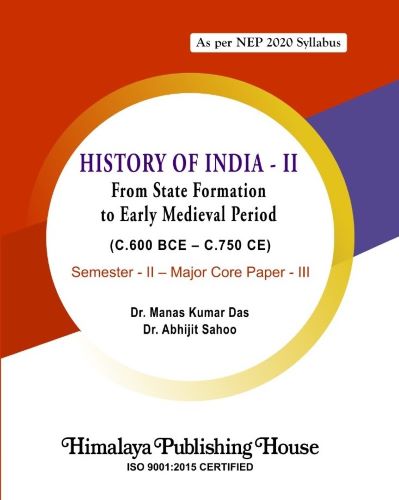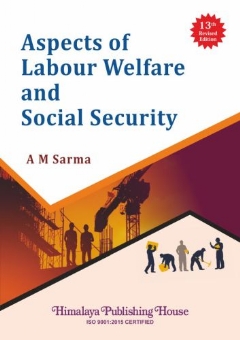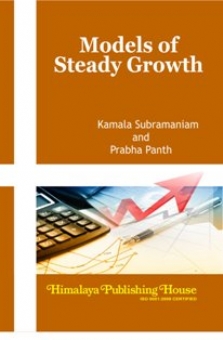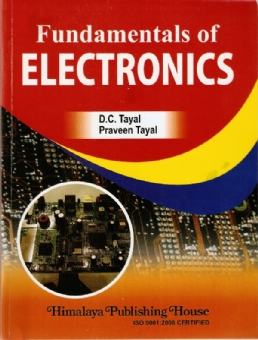History has its lingering presence on all aspects of human being, be it science, society, economy, politics or culture. India has explained to the world about the glories of her past achievements in the sphere of politics, religion, art, architecture and literature, etc. The book on “HISTORY OF INDIA-II (C.600 BCE – C.750 CE) has been written for the history Honours students as a Core Paper under the NEP-2020 syllabus adopted by the Universities and Autonomous Colleges of Odisha. For the convenience of the students, different terminologies are clarified, Summary recaps are given, point and sub-points are highlighted, Model Questions are given and LMR (Last Minutes Revision) is also supplied. In the first unit of the book, vivid depiction has been made on the Urban Growth, Material conditions such as agricultural expansion, Janapada Nivesa, Sixteen Mahajanapadas, Urban Centres, Trade and Commerce, Organisation of Production (Srenis), Trdae Routes, Social Stratification, Class, Varna, Jati, Gender, Buddhism and Jainism: Material milieu of Heterodoxies, Social Significance, Buddhist Sects, Major Principles of Jainism. In the following units, discussions were also made about the Mauryan Empire, Ashoka’s Policy of Dhamma, Reading Ashokan inscriptions, Administration, Economy, Decline, Post-Mauryan Politics: Kushanas, Satavahanas and Sangam in deep South, Indic Cultural Arc: India’s contact with China, Central Asia and Southeast Asia; Silk route and expansion of Buddhism. Focus has also been given on the Guptas–Political Developments: Expansion, Fragmentation and Huna Invasion from Samudra Gupta to Skandagupta, Literary and Scientific Developments during the Guptas; education in Nalanda, Development of Puranic Religions: Temples, Tirthas, Hindu pantheon. The subsequent chapter deals with topics like Agrarian Expansion, Land Grants, and Graded Land Rights, Peasantry, Varna, Proliferation of Jatis; changing norms of marriage and property, Post-Gupta polities–Pallavas, Chalukyas and Vardhanas.
Contents –
Unit – 1: Economy and Society (CIRCA 600 BCE To CIRCA CE 300)
1. Urban Growth: Material Conditions Such as Agricultural Expansion, Janapada Nivesa, Sixteen Mahajanapadas, Urban Centres: Trade and Commerce, Organisation of Products (Srenis), Trade Routes.
1.1 Urban Growth: Material Conditions such as Agricultural Expansion
1.2 Urban Growth
1.3 Material Conditions such as Agricultural Expansion
1.4 Impact of Agricultural Expansion in India (600 BCE – 300 CE)
1.5 Janapada Nivesa
1.6 Origins of the Janapadas
1.7 Classifications and Distribution of Janapadas
1.8 Decline and Transformation of Janapadas
1.9 Sixteen Mahajanapadas
1.10 Meaning and Sources of Mahajanapadas
1.11 Administration in the Monarchical and Republican States
1.12 Significant Features of the Mahajanapada Period
1.13 Decline of the Mahajanapada
1.14 Urban Centres in India (C.600 BCE – C.300 CE)
1.15 Causes of Urbanisation
1.16 Important Urban Centres
1.17 Urban Planning and Architecture
1.18 Social and Economic Life or Urban Centres
1.19 Decline and Transition
1.20 Trade and Commerce (CIRCA 600 BCE To CIRCA 300 CE)
1.21 Sources
1.22 Historical Background of Trade and Commerce in Ancient India
1.23 Infrastructure and Means of Exchange
1.24 Exports from Ancient India
1.25 Imports into Ancient India
1.26 Trade Networks and Routes in Ancient India (600 BCE – 300 CE)
1.27 Role of Guilds and Merchants
1.28 State Control and Regulation
1.29 Decline and Transformation of Trade and Commerce After 300 CE
1.30 Organisation of Production: Srenis in Ancient India (CIRCA 600 BCE To 300 CE)
1.31 Concept and Origin of Srenis
1.32 Structure and Internal Organisation
1.33 Types of Srenis (Guilds)
1.34 Role of Introduction and Economic Activities
1.35 Regulation of Production
1.36 Role in Economic Activities and Trade
1.37 Organisation of Labour
1.38 Economic and Social Functions
1.39 Role in Urban Development
1.40 Political and Administrative Roles
1.41 Legal and Political Status
1.42 Religious and Cultural Influence
1.43 Regional Examples of Evidence
1.44 Economic Impact and Integration
1.45 Challenges and Decline
1.46 Trade Routes (C. 600 BCE – 300 CE)
1.47 Historical Context of Trade Expansion
1.48 Major Trade Routes
1.49 Trade Infrastructure and Support Systems
1.50 Religious and Cultural Diffusion
1.51 Impact on Indian Society and Economy
1.52 Decline and Transformation Post 300 CE
1.53 Summary
1.54 Model Questions
2. Social Stratification: Class, Verna, Jati, Gender
2.1 Introduction
2.2 Social Stratification: Meaning and Definition
2.3 Class and Varna
2.4 Varna System and Jati
2.5 Four-Fold Division of Indian Society
2.6 Jati
2.7 Gender
2.8 Summary
2.9 Model Questions
3. Buddhism and Jainism: Material Milieu of Heterodoxies, Social Significance, Buddhist Sects, Major Principles of Jainism
3.1 Introduction
3.2 Factors Responsible for the Rise of Jainism and Buddhism
3.3 Buddhism
3.4 Early Life of Gautma Buddha
3.5 Principles/Teachings of Buddhism
3.6 Causes for Rapid Rise of Buddhism
3.7 Buddhist Councils
3.8 The Buddhist Literature and Philosophy
3.9 Major Schools of Buddhism
3.10 Buddhist Art and Architecture
3.11 Buddhism and Its Global Influence
3.12 Decline of Buddhism
3.13 Jainism
3.14 Parshvanatha
3.15 Mahavira’s Life and Teachings
3.16 Teachings/Principles of Jainism
3.17 Monastic Life and the Jaina Sangha
3.18 Jaina Scriptures and Literature
3.19 Jaina Art, Architecture and Culture
3.20 Spread of Jainism
3.21 Material Milieu of Heterodoxies
3.22 Social Significance of Buddhism
3.23 The Social Significance of Jainism
3.24 Buddhist Sects
3.25 Causes for the Emergence of Sects in Buddhism
3.26 The First Schism: Theravada and Mahasanghikar
3.27 Mahasanghika (The Great Assembly)
3.28 Mahayana Buddhism (The Great Vehicle)
3.29 Origins and Evolutions of Mahayana Buddhism
3.30 Key Doctrines of Mahayana Buddhism
3.31 Spread and Influence of Mahayana Buddhism
3.32 Vajrayana or Tantric Buddhism (The Diamond Vehicle)
3.33 Core Concepts and Practices
3.34 Philosophical Schools and Influences
3.35 Spread and Legacy of Vajrayana Buddhism
3.36 Vajrayana in Modern Times
3.37 Centres of Buddhist Sects in Ancient India
3.38 Decline of Sectarian Buddhism in India
3.39 Major Principles of Jainism
3.40 Summary
3.41 Model Questions
Unit – II: Changing Political Formation (CIRCA 300 BCE To CIRCA CE 300)
4. The Mauryan Empire: Ashoka’s Policy of Dhamma, Reading Ashokan Inscriptions, Administration, Economy, Decline
4.1 Introduction
4.2 The Mauryan Empire
4.3 Sources of Information of Mauryan History
4.4 Chandragupta Maurya
4.5 Origin and Early Life of Chandragupta Maurya
4.6 Conquest of Chandragupta Maurya
4.7 Administration of Chandragupta Maurya
4.8 Ashoka (273 BCE-232 BCE)
4.9 Conquest of Kalinga
4.10 Consequences of the Conquest of Kalinga
4.11 Ashoka’s Policy of Dhamma
4.12 Main Principles of Ashoka’s Dharma
4.13 Measures of Spread Dhamma or Dharma
4.14 Measures Taken by Ashoka for the Propagation of Dharma
4.15 Influence of Ashoka’s Dharma on Imperial Policy
4.16 The Impact of Ashoka’s Policy of Dhamma
4.17 Criticism and Limitations of Ashoka’s Policy of Dhamma
4.18 Propagation of Buddhism
4.19 Reading Ashokan Inscriptions
4.20 Theme of the Ashokan Inscriptions/Edicts
4.21 Historical Importance of Ashoka’s Inscriptions
4.22 Administration of Ashoka
4.23 Mauryan Economy
4.24 Successors of Ashoka
4.25 Decline of the Mauryan Empire
4.26 Summary
4.27 Model Questions
5. Post-Mauryan Politics: Kushanas, Satavahanas and Sangam in Deep South
5.1 Introduction
5.2 The Kushanas
5.3 Sources of History of the Kushanas
5.4 Origin of the Kushanas
5.5 Early Rulers of the Kushan Dynasty
5.6 Kadphises II or Wima Kadphises
5.7 Kanishka
5.8 Conquests of Kanishka
5.9 Extent of Empire of Kanishka
5.10 Administration of the Kushanas
5.11 Economic Prosperity During Kushana Period
5.12 Development of Literature During Kushana Period
5.13 Development of Religion During the Period of Kushanas
5.14 Development of Art and Architecture During Kushana Period
5.15 The Satavahanas
5.16 Early History of the Satavahanas
5.17 Administration of the Satavahanas
5.18 Social Organisation of the Satavahanas
5.19 Religious Conditions Under Satavahanas
5.20 Economic Conditions Under the Satavahanas
5.21 Learning and Literature
5.22 Development of Art and Architecture
5.23 Sangam in Deep South
5.24 Primary Sources Providing Information on the Sangam Age
5.25 Political History of the Sangam Period
5.26 Sangam Polity
5.27 Sangam Society
5.28 Economic Condition of the Sangam Age
5.29 Cultural Condition of the Sangam Age
5.30 Sangam Literature
5.31 End of the Sangam Age
5.32 Summary
5.33 Model Questions
6. Indic Cultural Arc: India’s Contact with China, Central Asia and South East Asia, Silk Route and Expansion of Buddhism
6.1 Introduction
6.2 Key Features of the Indic Cultural Arc
6.3 India’s Cultural Contact with China
6.4 India’s Cultural Contact with Central Asia
6.5 India’s Cultural Contact with South East Asia
6.6 Silk Route and Expansion of Buddhism
6.7 Summary
6.8 Model Questions
Unit – III: The Guptas
7. Political Developments: Expansion, Fragmentation and Huna Invasion From Samundragupta To Skandagupta
7.1 Introduction
7.2 Sources of Information
7.3 Foundation of the Gupta Empire
7.4 Chandragupta (320 CE – 335 CE)
7.5 Samudragupta (335 CE – 375 CE)
7.6 Conquests of Samundragupta
7.7 Chandragupta-II Vikramaditya (380 CE-414 CE)
7.8 Conquests of Chandragupta II
7.9 Successors of Chandragupta II
7.10 Later Guptas
7.11 Gupta Administration
7.12 Fragmentatin and Huna Invasion From Samudragupta to Skandagupta
7.13 Effects of Huna Invasion
7.14 Decline of the Gupta Empire
7.15 Summary
7.16 Model Questions
8. Literary and Scientific Developments During the Guptas Education in Nalanda
8.1 Introduction
8.2 Development of Literature During Gupta Period
8.3 Development of Science and Technology During Gupta Period
8.4 Astronomy and Astrology
8.5 Education in Nalanda
8.6 Foundation and Historical Content
8.7 Architectural Layout and Campus Life
8.8 Admission and Student Selection
8.9 Curriculum and Subjects of Study
8.10 Teachers and Notable Scholars
8.11 International Influence and Global Connections
8.12 Summary
8.13 Model Questions
9. Development of Puranic Religions: Temples, Tirthas, Hindu Pantheon
9.1 Introduction
9.2 Development of Puranic Religions
9.3 Historical Background
9.4 The Puranas: Texts and Tradition: Structure and Scope
9.5 Rituals, Temples and Iconography: Temple Worship
9.6 Temples in the Development of Puranic Religions
9.7 Famous Temples of the Puranic Era
9.8 Temples and Puranic Cosmology
9.9 Thirthas in the Development of Puranic Religions
9.10 Concept and Significance of Tirtha
9.11 Socio-Cultural Impact of Tirthas
9.12 The Hindu Pantheon
9.13 Transition from Vedic to Puranic Deities
9.14 The Major Divinities of the Puranic Pantheon
9.15 Other Important Members of the Pantheon
9.16 Summary
9.17 Model Questions
Unit – 4: Towards Early Medieval India (CIRCA CE Fourth Century To CE 750)
10. Agrarian Expansion, Land Grants, Graded Land Rights, Peasantry
10.1 Introduction
10.2 Towards Early Medieval India
10.3 Agrarian Expansion
10.4 Land System Under the Kushanas and Satavahanas
10.5 Expansion of Agriculture During the Guptas
10.6 Land Grants
10.7 Graded Land Rights and Peasantry
10.8 Position of the Peasantry
10.9 Summary
10.10 Model Questions
11. Varna, Proliferation of Jatis: Changing Norms of Marriage and Property
11.1 Introduction
11.2 Varna System
11.3 Four-Fold Division of Indian Society
11.4 Jati
11.5 Proliferation of Jatis
11.6 Changing Norms of Marriage and Property
11.7 Property Relations
11.8 Summary
11.9 Model Questions
12. Post–Gupta Politics – Pallavas, Chalukyas
12.1 Introduction
12.2 Sources for the History of the Pallavas
12.3 Origin of the Pallavas
12.4 Political History of the Pallavas
12.5 Administration of Pallavas
12.6 The Chalukyas
12.7 Origin of the Chalukyas
12.8 The Chalukyas of Vatapi or Badami
12.9 The Later Chalukyas of Kalyani (Western Chalukyas)
12.10 The Eastern Chalukyas of Vengi
12.11 Summary
12.12 Model Questions
13. The Vardhanas
13.1 Introduction
13.2 Sources of Harsha’s Reign
13.3 Pushyabhuti Dynastry
13.4 Achievements of Harsha
13.5 Administration of Harsha
13.6 Summary
13.7 Model Questions
Last Minute Revision







